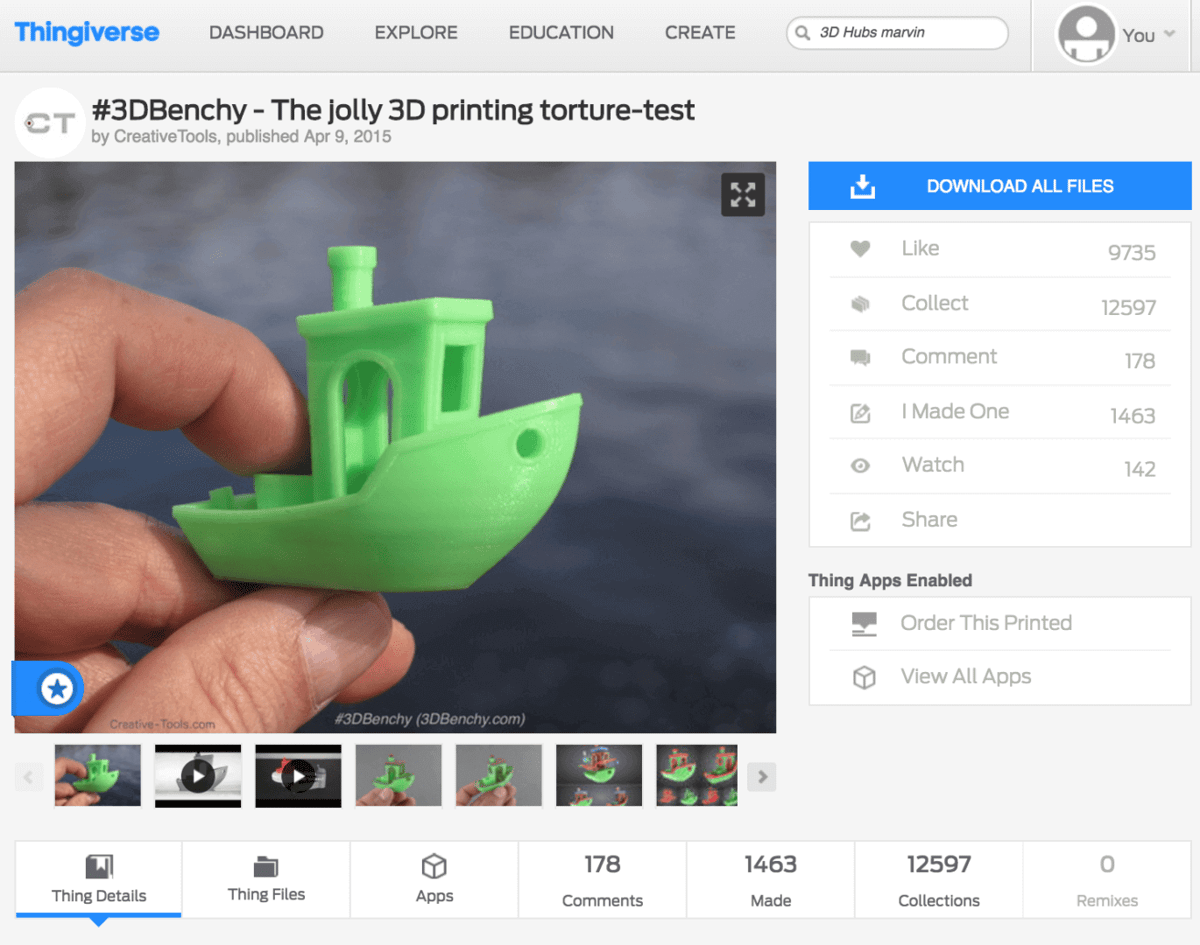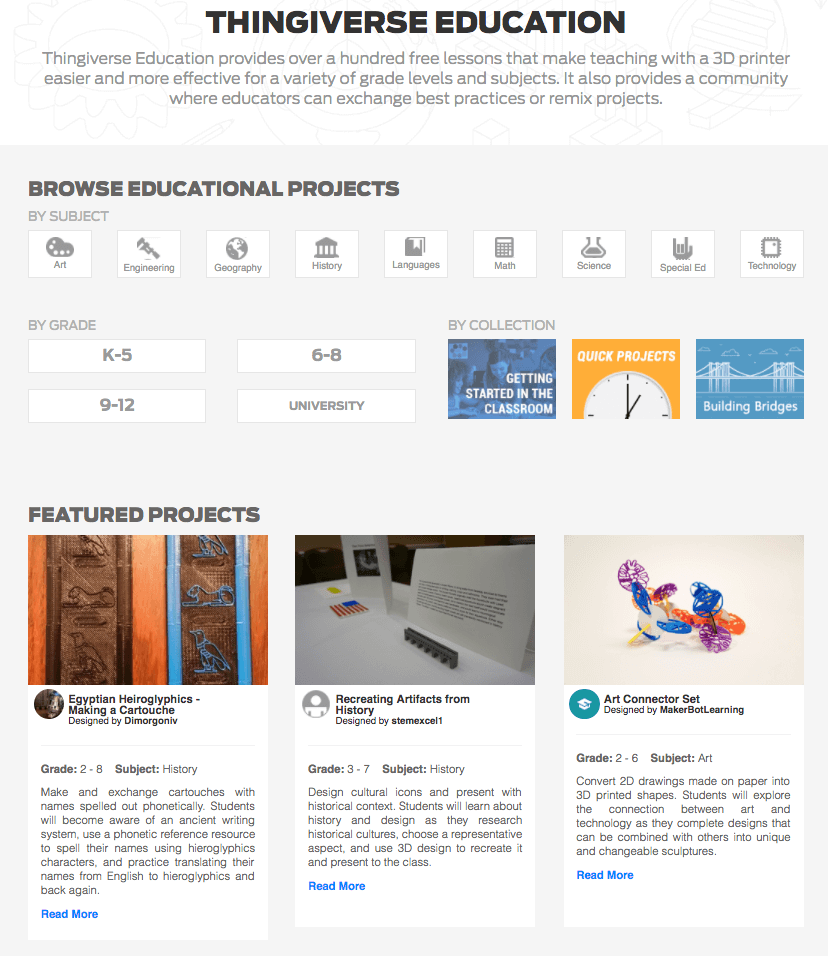MakerBot employees share an exclusive look at Thingiverse, the pioneering 3D printing marketplace and community.
If you’ve ever used a desktop 3D printer before, chances are you’re more than familiar with the Thingiverse platform. This 3D printing marketplace and community offers thousands of models that can be freely shared, downloaded, remixed, and of course, printed.
The platform was launched by MakerBot back in 2008, and has been expanding ever since. Nowadays, Thingiverse boasts millions of users and uploaded 3D models, offering everything from popular torture tests like the 3DBenchy to full-fledged educational lesson plans.
Intrigued by the continuous growth of this 3D printing marketplace, we decided to take a deeper plunge into this immensely popular platform. We recently chatted with Public Relations Manager Josh Snider, MakerBot Learning Manager Drew Lentz, and Thingiverse Product Manager Corey Zettler about the inner happenings of Thingiverse.

Q: How did Thingiverse grow into its own entity separate from MakerBot?
Josh Snider / MakerBot Public Relations Manager: After MakerBot went closed source in 2014, we were careful to treat Thingiverse with a brand agnostic touch. Thingiverse represents a portion of the 3D printing community that MakerBot no longer spoke for. So, it’s a cool slice of all 3D printing users from RepRap users, to
Q: Most popular items on Thingiverse?
Josh: The most downloaded thing is essential calibration sets and a bunch of other tuning prints. The most things that people have made and posted makes of is the 3DBenchy and then the 3D Hubs Marvin symbol. The guy who kind of looks like a bomber man character. The biggest category is household stuff. The Thingiverse superlatives are quite interesting, and some of them not really typical of Thingiverse itself.

Q: What have you noticed is trending on Thingiverse lately?
Corey Zettler / Thingiverse Product Manager: One of the biggest trends we’ve seen now is the Hairy Lion or Albert Einstein models. That’s a new technique that’s been figured out through multiple kinds of 3D printing. Taking the printing material for 3D prints and deciding to use a hair dryer and heat to style it in terms of actual hair is just an idea that someone created on their own and uploaded. We’ve seen some of the most interesting and creative remixes of that style of printing just on its own.
Josh: Another thing, I don’t know if you’ve noticed, but the fidget toys are a big craze that’s happening between educators and designers. I think that’s a really good use of the platform. Where talented designers meet the needs of educators in the classroom. I think it’s a really powerful story, and that has become really popular. And by featuring that, it kind of builds on itself.
Don’t Miss: 55 Best Fidget Spinner Toys to Buy or DIY
Q: Most remixed item?
Josh: Oddly enough, one of them looks like an openSCAD protocol for putting text on an object, which is an interesting nod to Thingiverse’s ability to print non-3D printable things. It still features things that are CNC millable. It features assemblies of things, just the general construction of things in either the 3D printable or maker world.
Q: How has the growth of Thingiverse changed overtime?
Josh: There are over 4.8 million things downloaded each month. I think Thingiverse Education is now at over 260 lesson plans. We had 200 a couple of months ago, so it’s growing rather rapidly. There are over 2 million uploaded things, and they are uploaded at a rate of about 50-60 thousand things per month. And, there’s probably a good 10-15% growth on these numbers since we looked them up in December. Thingiverse has a history of rapid growth. Non-stop growth. But it’s not something we’re going to take credit for ourselves; it’s really all thanks to the community.
Corey: We like to look at things on a larger scale, but we’ve definitely crossed the 3 million active-user threshold. Sometime in the late summer, we were at 2 million. So, over the last few months, we see that it’s definitely increasing steadily. And everything is moving in tandem, so uploads and downloads are all increasing and hitting record highs. New registrations per week. We’re definitely looking at some high organic growth on the Thingiverse site and it’s been steady. So, it’s something we’re positive about and happy to see.
Q: What role does Thingiverse Education play in expanding the platform?
Drew Lentz / MakerBot Learning Manager: There’s a huge presence of educators on Thingiverse. I think one of the most powerful things as a company that we can do is connect these experts who have been involved in 3D printing, building their own 3D printers since 2010 and before that; connecting them with educators who are new to 3D printing and are trying to use new technology for their students in their classroom. By cultivating that community and connecting the professionals with the educators, that’s how we see the growth and the self-sustaining mentality of Thingiverse progressing.

Q: With such a massive amount of users, how do you prevent inappropriate or poor quality models from making it onto the platform?
Drew: Luckily, MakerBot is full of a bunch of 3D printing enthusiasts that love Thingiverse, so we have our own team here that’s perusing Thingiverse constantly. So, we have our own policing in-house. And then, luckily, with such an awesome community, we’re alerted to things almost immediately. If something comes up that is inappropriate, violates the terms of service, or is faulty, we get a notification almost immediately. And our whole team here can react to that. Take it down, flag it, moderate it.
Q: How do you protect the Intellectual Property of your users?
Corey: Once you have a user base as large and storied as Thingiverse, the community polices itself in an amazing way. Most of the designs are creative commons, which means anybody can go and print them. From time to time, we get complaints of content that needs to be taken down.
But our legal department is very quick to comply with any content removal requests that designers send us. That being said, the community does a really good job in policing itself. So, when there is something shady going on in terms of users printing things, users taking designs from other websites, or if it’s the users that own the property, that are alerting us first to some shady business. They’re very protective of the website and the way things go.
Q: What does the future hold for Thingiverse?
Josh: I think that we’re just hitting the beginning of the Thingiverse stride for a couple of reasons: One, Thingiverse education is a newer market in terms of where 3D printing can go. And because it hasn’t been touched in so many areas yet, there’s so many directions that it can go.
I think the other thing, too, is the fact that 3D printing in the consumer industry is still very new. We haven’t yet seen what can really happen. So, the fact that there is a place where users can put all the designs, and makes, and creative ideas, in one place that’s been established for so long already, it’s only going to serve it better as the industry grows.
Thingiverse posts every kind of 3D printer, every kind of platform. Anything users and makers use to design their models, we host, and we push for. So, I feel that the up slide for Thingiverse is unlimited; especially as the industry itself continues to grow.
License: The text of "Thingiverse: An Inside Look At The Leading 3D Printing Marketplace" by All3DP is licensed under a Creative Commons Attribution 4.0 International License.